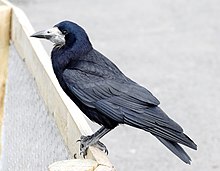
Corvus frugilegus

The rook (Corvus frugilegus) is a member of the crow family in the passerine order of birds. It is found in Eurasia, its range extending from Scandinavia and western Europe to eastern Siberia. It is a large, gregarious, black bird, distinguished from similar species by the whitish featherless area on the face. Rooks nest collectively in the tops of tall trees, often close to farms or villages, the groups of nests being known as rookeries. Rooks are mainly resident birds, but the northernmost populations may move southwards to avoid the harshest winter conditions. The birds form flocks in winter, often in the company of other Corvus species or jackdaws. They return to their rookeries and breeding takes place in spring. They forage on arable land and pasture, probing the ground with their strong bills and feeding largely on grubs and soil-based invertebrates, but also consuming cereals and other plant material. Historically, farmers have accused the birds of damaging their crops, and have made efforts to drive them away or kill them. Like other corvids, they are intelligent birds with complex behavioural traits and an ability to solve simple problems. The rook was given its binomial name by the Swedish naturalist Carl Linnaeus in 1758 in his Systema Naturae. The binomial is from Latin; Corvus means 'raven', and frugilegus means for 'fruit-gathering'. It is derived from frux or frugis, meaning 'fruit', and legere, meaning 'to pick'. The English-language common name rook is ultimately derived from the bird's harsh call. Two subspecies are recognised; C. f. frugilegus, the western rook, ranges from western Europe to southern Russia and the extreme northwest of China, while C. f. pastinator, the eastern rook, ranges from central Siberia and northern Mongolia eastwards across the rest of Asia. Collective nouns for rooks include building, parliament, clamour and storytelling. Their colonial nesting behaviour gave rise to the term rookery. The rook is a fairly large bird, at 45 to 47 cm (18 to 19 in) in length, with black feathers that often show a blue or bluish-purple sheen in bright sunlight. The feathers on the head, neck and shoulders are particularly dense and silky. The legs and feet are generally black, the bill grey-black and the iris dark brown. In adults, a bare area of whitish skin in front of the eye and around the base of the bill is distinctive, and enables the rook to be distinguished from other members of the crow family. This bare patch gives the false impression that the bill is longer than it is and the head more domed. The feathering around the legs also appears shaggier and laxer than the similarly sized carrion crow, the only other member of its genus with which the rook is likely to be confused. Additionally, when seen in flight, the wings of a rook are proportionally longer and narrower than those of the carrion crow. The juvenile plumage is black with a slight greenish gloss, except for the hind neck, back and underparts, which are brownish-black. The juvenile is superficially similar to a young crow because it lacks the bare patch at the base of the bill, but it has a thinner beak and loses the facial feathers after about six months. Rooks are resident in the British Isles and much of north and central Europe but vagrant to Iceland and parts of Scandinavia, where they typically live south of the 60th latitude. They are found in habitats that ravens dislike, choosing open agricultural areas with pasture or arable land, as long as there are suitable tall trees for breeding. They generally avoid forests, swamps, marshes, heaths and moorland. They are in general lowland birds, with most rookeries found below 120 m (400 ft), but where suitable feeding habitat exists, they may breed at 300 m (1,000 ft) or even higher. Rooks are often associated with human settlements, nesting near farms, villages and open towns, but not in large, heavily built-up areas. The rook also occurs as an eastern species in Asia where it differs in being slightly smaller on average, and having a somewhat more fully feathered face. In the north of its range the species has a tendency to move south during autumn, and more southern populations are apt to range sporadically. The species has been introduced into New Zealand, with several hundred birds being released there from 1862 to 1874. Although their range is very localized, the species is now regarded as an invasive pest and is the subject of active control by many local councils. This has wiped out the larger breeding colonies in New Zealand, and the remaining small groups have become more wary.
